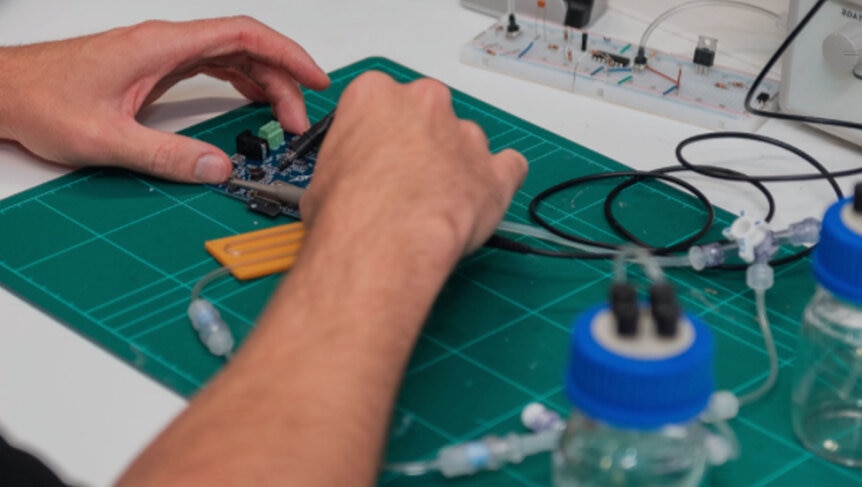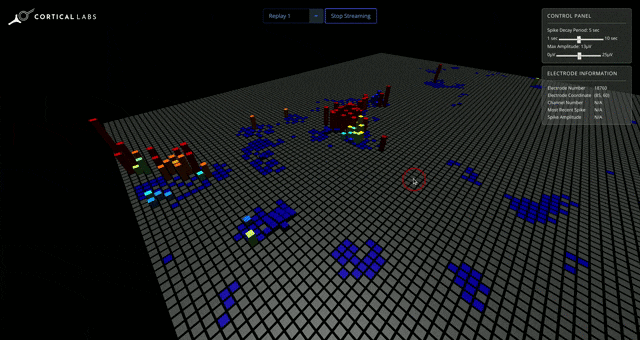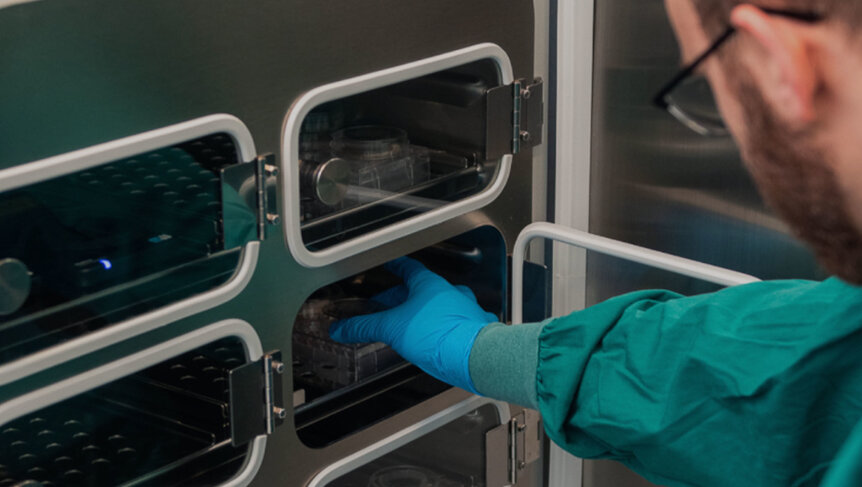Create a free profile to get unlimited access to exclusive videos, sweepstakes, and more!
Exclusive: Meet the scientists reversing robotics by putting the man into the machine

By now, so many cyborg-esque technologies exist that we’re living in what was the imagined future of yesterday — think Neuralink, brain-computer interfaces, and mind-controlled weapons. It’s almost like living in Star Trek or The Matrix.
Cortical Labs is not your average robotics startup. Instead of creating artificial technology that is programmed to function like the human brain, they have developed silicon computer chips that merge with actual neurons to think on their own. SYFY WIRE interviewed co-founders Dr. Hon Weng Chong and Andy Kitchen to find out more about this extraordinary biotech that puts the brain into the computer rather than putting a computer in the brain.
So how do neurons and tech connect? There are no invasive procedures involved. The neurons used are actually human skin cells that have been morphed into stem cells (which have the potential to become anything) and then morphed again into neurons. These become integrated with a micro-electrode array that is really a physical grid of microscopic electrodes that are about 17 microns apart. Under a microscope, it kind of looks like the flat, iridescent chips inside of a DSLR camera. The sci-fi tech that comes closest is those bio-neural gel packs from Star Trek: Voyager, whose organic circuitry allowed them to think as if they were alive.
“It takes up very very faint electrical signals in microvolts, meaning one millionth of a volt, so very slight changes in the electrical voltage,” Kitchen explained. “Then what we do is we basically grow cells in contact with that electrode grid so the cells are spread out on top of this grid of electrodes. The cells are so close and the electrodes are so sensitive that you know when neurons are firing.”
Such hypersensitive electrodes can pick up when there is action potential, and this is when a spike in neuron firing, which goes up to millions of microvolts, can be observed. Younger cells will fire less strongly while older cells have more firepower. You need to get information out, but you also need to get information in by using biologically compatible stimuli to stimulate the neurons with highly precise and targeted volts. Neurons need to fire with a frequency that will effectively encode a message or other information into this bio-neural network. It’s basically the inverse of something like Neuralink.
By the way, these things can play Atari. Anyone who ever spent way too many hours in the arcade playing Pong will know what the neuron chips are up to.
“It’s about input and output,” said Chong, comparing them to denizens of the simulated world in The Matrix. “There’s a matrix and these neurons actually live in a vertical simulation where they are constantly stimulated, so they basically live in a virtual simulation where they see a ball, feed themselves that input, then give the output.”
He then echoed that eerie Morpheus speech about consciousness really being just a computer simulation working off electrical impulses in our brains.
But how do these things even concentrate on a video game? They are trained in a computational task called lines of separation. Think of being at a party where the music is blasting, people are shouting over the music and you’re the one in the corner struggling to keep a conversation going. Now imagine if you could just focus on whatever you’re talking about and filter all that extraneous noise out. The neuron chips can actually separate signals so they know what they’re going. Chong and Kitchen have visions for them that go far beyond the pixelated world of retro video games.
“I want to use it in robotics — biological systems are really good for that since they’ve been evolved to sort of operate in highly stochastic, highly variable environments where they always have to model the world they live in and also learn to remodel themselves to new environments for the betterment of humanity,” said Chong. “One of the things that I’d really love to do is open up this technology to researchers and expand it around the world so it can be applied in whatever way it would be useful.”
Of course, the tech won’t be running entire data centers right away, though Chong hopes that is one of the things it will eventually be capable of. Just like it started out playing Pong (will it attack Space Invaders next?), its early tasks could be turning thing on and off or making basic calculations that could save you time putting together those spreadsheets you were dreading. Later it might be able to think for something like a Roomba.
Fast-forward to when the chips get more advanced, and the cells will be genetically engineered with specific computation elements, so while they are still the bio-component of this technological Frankenstein, they will evolve enough to break away from basic biological functions and be able to target more specific computational purposes. They could even be the actual brains of humanoid robots.
“In terms of where this is going, we’ve roughly figured out three phases, and we kind of see between them several orders of magnitude in terms of size, number of neurons, number of connections, and the amount of information you get in and out,” Kitchen said. “So phase one would involve thousands of electrodes and hundreds of thousands of neurons. Then I think we would be moving to hundreds of thousands of electrodes, millions of neurons and so on.”
There is one issue with a hybrid computer system like this that you probably don’t think of when your smartphone is at 2 percent power and you have to plug it in to recharge. Neurons need nutrients to keep going. Any device that will use Cortical Labs’ technology will need refills of nutrient-rich material, which its creators imagine kind of like a Keurig machine. You’d put the refill cartridge in the top much like a K-cup. Unlike our phones, which are always dying at the most inconvenient moments, that would be enough to supply a device using the neuron chips with weeks' and even months' worth of power.
“In the future, you will probably have to excuse yourself because you have to feed your computer,” Chong laughed.
So is Westworld going to be our new reality? Probably not, if you ask Chong and Kitchen, but they also admitted it’s too early to tell. Fluid intelligence is what they’re going for right now. The more complex devices that think with these chips should be capable of creativity, not just crunching numbers or other data. They do someday want to see if they can teach the chips right and wrong, starting from correct and incorrect and moving into ethics that are often nebulous.
Humans will someday give robots the ability to decide whether what it’s doing it’s right or wrong, and then be able to push it down the right path. This is going to take a while. What seems ethically right to some people could freak others out.
“Consciousness is technically possible, but we don’t know what it is or how to measure or define it yet,” Chong said. “These are the very early days, but I do believe that consciousness is achievable. If one of our cultures escapes the lab, we’ll give you a call.”





























